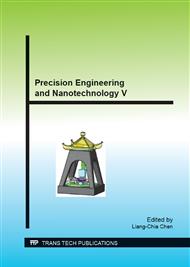p.172
p.178
p.182
p.187
p.192
p.196
p.201
p.207
p.213
Finishing of 4H-SiC (0001) by Combination of Thermal Oxidation and Abrasive Polishing
Abstract:
4H-SiC is considered as one of the most promising next-generation semiconductor power-device materials. An atomically flat 4H-SiC surface with a well-ordered step/terrace structure was essential for epitaxial growth or applications in electrical devices. Plasma assisted polishing (PAP), in which the irradiation of atmospheric-pressure water vapor plasma and ceria (CeO2) abrasive polishing were combined, was successfully applied to the atomic-scale flattening of 4H-SiC. To clarify the atomic-scale flattening mechanism of 4H-SiC in PAP process, investigations of thermal oxidation of 4H-SiC were conducted. Cross-sectional transmission electron microscopy (XTEM) observations revealed that the interfaces between the thermal oxidized oxide layer and SiC were very flat regardless of the thickness of the oxide layer. Dipping in hydrofluoric acid for 10 min and CeO2 abrasive polishing for 3 h were respectively conducted on a 4H-SiC surface which was thermally oxidized for 2 h. A flat surface was obtained after dipping in HF acid. However, no step/terrace structure, which corresponds to the inclination of the crystal plane, could be observed due to the residual of silicon oxycarbide. A well-ordered step/terrace structure was obtained on the surface polished by CeO2 abrasive. The step height was about 0.25 nm, which corresponds to a one-bilayer structure of 4H-SiC. The different oxidation rates of Si atoms on the cubic face and Si atoms on the hexagonal face were considered the reason why two kinds of terraces with different width were generated.
Info:
Periodical:
Pages:
192-195
Citation:
Online since:
August 2014
Authors:
Keywords:
Price:
Сopyright:
© 2015 Trans Tech Publications Ltd. All Rights Reserved
Share:
Citation:


